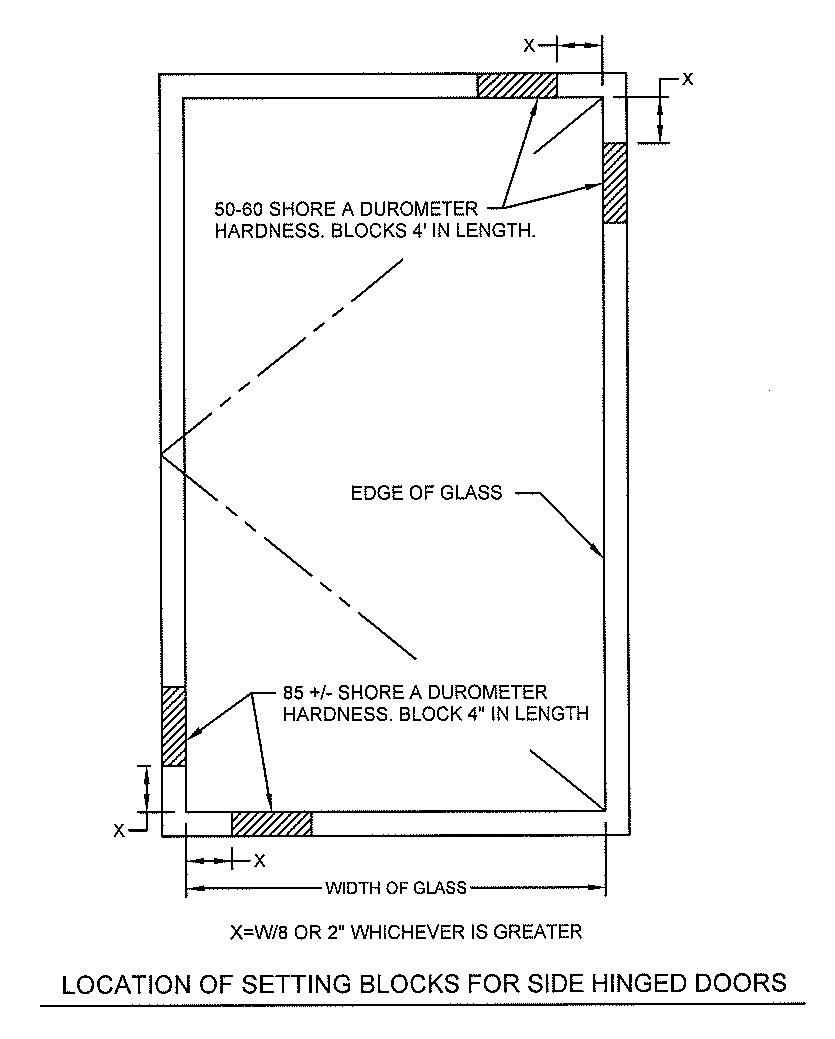GUIDELINES ON HOW TO INSTALL STEEL DOORS
These guidelines are meant to be general in nature. They are not intended to supersede or replace the installation instructions provided by the door manufacturer. Please contact the door manufacturer for specific installation instructions or installation drawings.
NOTE: These guidelines apply to steel swing doors made from hot rolled purpose-made steel sections designed for doors.
CAUTION: These guidelines were written with regard for the safety of workers and bystanders; however normal safety procedures, codes and regulations take precedence over the guidelines presented here. Consult OSHA regulations, local laws and building codes when working above sidewalks, pathways, or other locations where falling debris may cause injury to personnel. Appropriate personal protective equipment (safety glasses, gloves, back braces etc.) must be used during the door installation to prevent injury. Installer and end user should be aware of pinch points (hinges, latches, movable vents, and all joining parts) to avoid injury.
GETTING STARTED
Steel doors are designed to be installed directly into structural openings of wood, masonry, block, brick, or structural steel. Typically, they are connected to the structural opening by either fastening directly through the door frame, or by anchor straps provided by the door manufacturer.
Hot rolled steel doors are typically shipped unglazed, and therefore are installed in the structural opening before glazing. Steel doors may be shipped with the door leaf(s) shipped separately or with the door leaf(s) assembled to the door. If the door leaf(s) is separate, the door leaf(s) must be matched with their respective frames (follow markings). It is important to note that door leaves are not interchangeable - they are matched to their individual frames - even where multiple doors of the same size are manufactured. Typically, doors are installed & glazed as a completed assembly.
Although steel doors are hung, bedded, fitted & inspected at the factory, it is important to have a proper installation to ensure the door operates properly in the field.
Since steel swing doors are custom fabricated from thin member hot rolled steel sections, they are malleable and subject to racking; therefore, great care is needed to insure they are installed level, plumb & square. The installer should determine that the materials used will provide adequate support for the weight of the door & glass.
THE OPENING
Before installing a steel door, the opening needs to be measured for width and height and compared to the door size to make sure that a gap exists all around between the door and the opening. The opening should be measured at the top and bottom (for the width measurement), and at both sides (for the height measurement). The opening should also be checked for plumb, level & square. This gap between the door and the opening allows for construction tolerances, door fabrication tolerances, out of square variations in the opening, and thermal movement of the door. In general, a 1/4" design gap between the door and the opening all around is typical; however, this gap should not be smaller than 1/8" and not greater than 1/2". In retrofit installations where multiple doors of the same size are being installed, the openings may be slightly different sizes and therefore the gaps will vary. Check the opening for squareness and adjust as necessary. Remove any objects that may obstruct the door from freely sliding into the opening.
PLACING THE DOOR INTO THE OPENING
If the door is installed by fastening directly through the frame, apply filler shims to the door frame, then slide the door frame into the opening in its desired position, taking care not to force or pry it into place. If the installation requires anchor straps, attach the straps to the door frame at the locations specified by the door manufacturer before the door is placed into the opening. With the door leaf open at 90 degrees, the end of the vent can be blocked off the floor to allow the door frame to be shimmed into the opening.
Shim the door on all sides in the opening using flat non-corrosive fixing shims, making sure it is level, plumb & square. This can be done with a level, however using a laser system gives the best precision. On installations using anchor straps, they should protrude towards the interior.
FASTENING THE DOOR
Once the door is level, plumb & square, 1/4" fasteners are used to anchor the door into the opening. The fasteners need to be suitable for the type of material the structural opening is made of. If fastening through the frame, holes will be provided for the fasteners in the door frame by the manufacturer. If using anchor straps, drill a hole in the strap at the desired location for the anchor fastener. Once the frame is installed in the opening, check the frame for level & plumb again. Check the width of the door at many points from the sill to the head to make sure there is no bowing of the jambs. Any bowing discovered needs to be corrected by re-shimming. By measuring inside/ outside dimensions around the frame, make sure that there is no twisting of the frame members. Seal all fasteners where they penetrate the frame.
SEALING THE EXTERIOR PERIMETER GAP
Seal the exterior gap between the door and the structural opening with a sealant that is compatible with the door and opening material, the gap size and configuration, the weather exposure, and the expected movement of the door. Follow the recommended installation instructions of the sealant manufacturer. Gaps of 1/8" can usually be filled with sealant only, however gaps over 3/16" usually require a backing material such as backer rod to support the perimeter seal. The depth of the sealant in the joint gap should be 1/4" for non-porous materials, and 3/8" if porous materials are present in the opening. After caulking, neatly point the sealant.
GLAZING THE DOOR WITH GLAZING BEADS
CAUTION! Wear personal protective equipment (safety glasses, gloves, etc.) when handling and installing glass.
Hot rolled steel doors may ship with the aluminum glazing beads installed and taped in place. It is important to remember that steel doors are custom made, and therefore similar parts are not always interchangeable. Remove the glazing beads one at a time, marking the locations they came from so they can go back in the same positions.
Clean the glazing rebate, making sure all dust, dirt and oil are removed. Apply glazing tape to the perimeter of the glazing rebate. The glazing tape should be compatible with the type of glass being used. Consult the door manufacturer for the size and type of glazing tape to use.
Glazing steel doors is an instrumental part of the installation and requires precise blocking of the glass to ensure proper operation and weathertight seal. Prior to glazing it is suggested that operable panels are closed, and hardware engaged in the closed position. Add temporary shim underneath operable panel.
Determine the size and locations for the glass setting & edge blocks to center the glass in the opening. Glass should be set on two identical neoprene, EPDM, silicone, or other compatible elastomeric setting blocks with a Shore (Type) A durometer of 85+/-5. The width of setting blocks should be at least 1/8" (3 mm) wider than the glass thickness. The glass should be free to move within the glazing pocket without touching the frame. The glass should have adequate clearance around all edges, so it does not contact the framing system during static or dynamic conditions. A useful guide to follow in glazing doors is National Glass Association's GANA Glazing Manual.
Place setting and edge blocks only in the locations as shown in the illustration below.

Remove the protective tape from the glazing tape.
Insert the glass, centering it in the opening, and gently press it against the glazing tape.
Usually, the glazing beads are held in place by clips pre-attached to the door frame. Snap the glazing beads into the clips between the glass and the frame. Consult the window manufacturer for instructions about the sequence of installing glazing beads.
Install the rubber glazing gasket between the glass and the glazing beads. It helps to use a mild soap or an ammonia free glass cleaner as a lubricant to install the rubber gasket. If simulated divided lites (SDL's) are present, they can be applied to the glass. Cap bead the SDL's.
Apply a cap bead of silicone sealant to the outside surface of the glass where it meets the frame.
AFTER THE DOOR IS INSTALLED
If steel doors are properly installed and maintained, it is possible for them to last the life of the building. After the door is installed, verify that the door operates correctly. Handles, locks, and throw bolts (if required) should be checked for proper operation and should move freely. Door vents must operate smoothly and close tightly. Rubber weather seals should not have any nicks, tears, or cuts. Check to make sure that weather seals are sealing properly on all sides of doors. Make any adjustments necessary or as recommended by the door manufacturer. Any scratches or digs in the paint finish should be repaired with touch up paint as recommended by the door manufacturer. Make sure all drill shavings are removed as they will rust and mar the paint finish.
Check to make sure that any drain holes in the outer frame sill are clear and unobstructed to insure correct weather performance.
Once the door operates satisfactorily, clean the door using a mild non-alkaline soap and warm water, applied with a sponge or soft cloth. Rinse with clear water.
1300 Sumner Avenue Cleveland, OH 44115-2851
216 - 241 - 7333 | swi@steelwindows.com
© The Steel Window Institute (2019) Contents are the property of the Steel Window Institute, its members or others who have licensed the information. All rights reserved.







